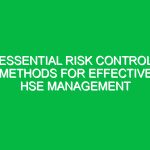Introduction
In today’s increasingly complex work environments, mental health Safety moments have emerged as a crucial component of Health, Safety, and Environment (HSE) practices. A mental health Safety moment is a brief, focused discussion or reflection aimed at raising awareness about mental well-being in the workplace. This concept is not merely an add-on to existing safety protocols; it plays a vital role in fostering a culture of safety that encompasses not just physical but also psychological well-being.
As organizations strive for comprehensive safety programs, addressing mental health becomes essential in preventing workplace incidents and fostering a supportive environment. In this article, we will delve into the significance of mental health safety moments, explore how they can be effectively implemented, and understand their impact on overall HSE success.
The Importance of Mental Health Safety Moments
Mental health safety moments serve multiple functions within the HSE context:
- Awareness Raising: They help to create awareness around mental health issues, breaking down stigma and encouraging open discussions.
- Preventive Measures: By addressing mental health proactively, organizations can reduce the risks associated with mental health crises, such as burnout or anxiety-related disorders.
- Enhanced Productivity: Employees who feel supported in their mental health are more engaged and productive, which ultimately Benefits the organization.
- Improved Safety Culture: A workplace that prioritizes mental health fosters a culture where employees feel safe to express their concerns, leading to better overall safety outcomes.
Key Components of Mental Health Safety Moments
To effectively integrate mental health safety moments into HSE practices, organizations must consider several key components:
1. Training and Education
Training employees to recognize the signs of mental health struggles in themselves and their colleagues is fundamental. This involves providing resources and Training sessions that equip employees with the skills to support one another. For instance, a construction company might hold regular workshops focused on identifying stress and anxiety signs in high-pressure situations.
2. Open Communication
Creating a culture where employees feel comfortable discussing mental health is vital. Encouraging open dialogue can be achieved through regular team meetings or informal check-ins. An example of this is a manufacturing plant that initiates weekly “mental health check-ins” as part of their safety meetings, allowing employees to share their experiences and coping strategies.
3. Accessible Resources
Organizations must provide easy access to mental health resources, such as counseling services, hotlines, or employee assistance programs (EAPs). Companies can also create mental health toolkits with helpful information and resources, ensuring that employees know where to turn in times of need.
4. Regular Mental Health Safety Moments
Incorporating mental health safety moments into routine safety briefings or team huddles can keep mental well-being at the forefront. These moments can take the form of discussions, sharing personal stories, or reviewing strategies for maintaining mental wellness amid workplace stressors.
Real-Life Examples and Case Studies
Integrating mental health safety moments into an organization’s culture can have profound Effects.
Case Study: A Construction Firm’s Journey
A prominent construction firm faced high turnover rates and increasing incidents of absenteeism due to stress-related issues. The management decided to implement mental health safety moments, starting with training sessions for all employees to emphasize the importance of mental well-being.
Over six months, the company noticed a significant decline in absenteeism, and employee feedback indicated that workers felt more supported. The firm reported increased morale and productivity, demonstrating that prioritizing mental health can lead to tangible benefits.
Hypothetical Scenario: The Warehouse Environment
Imagine a warehouse where employees often work long shifts, leading to fatigue and stress. The management introduces a weekly mental health safety moment where employees can share experiences and coping strategies. After a few months, the management notices a drop in workplace accidents, attributed to improved mental clarity and focus among workers.
Potential Hazards and Risks
While mental health safety moments are invaluable, organizations must also recognize the potential risks associated with neglecting mental well-being:
- Burnout: Prolonged stress without support can lead to burnout, which diminishes employee performance and satisfaction.
- Increased Incidents: Poor mental health can contribute to higher rates of workplace accidents, as distracted or distressed employees may not be fully attentive to their tasks.
- Stigma: Failure to address mental health issues can perpetuate stigma, making employees reluctant to seek help and further exacerbating problems.
Best Practices for Implementing Mental Health Safety Moments
To reap the benefits of mental health safety moments, organizations can adopt Best Practices that enhance their HSE frameworks:
1. Leadership Involvement
Leadership should actively participate in mental health initiatives, demonstrating their commitment to employee well-being. This can include sharing personal mental health experiences or publicly supporting mental health resources.
2. Tailoring Programs
Every workplace has unique challenges, so it’s crucial to tailor mental health safety moments to fit the specific needs and culture of the organization. Regular surveys and feedback sessions can help identify areas for improvement.
3. Celebrating Successes
Recognizing and celebrating improvements in mental health can reinforce the importance of these safety moments. For example, organizations can highlight teams that have effectively integrated mental health discussions into their workflow.
Regulations and Standards
While there may not be specific Regulations solely dedicated to mental health safety moments, various Occupational Health and safety standards stress the importance of mental well-being in the workplace. For instance, the Occupational Safety and Health Administration (OSHA) emphasizes the necessity of maintaining a safe work environment that includes psychological safety.
Employers are encouraged to evaluate how mental health impacts overall safety and to implement programs that support mental health as part of their compliance with general safety regulations.
Conclusion
In summary, mental health safety moments are integral to the success of Health, Safety, and Environment initiatives. By fostering a culture that prioritizes mental well-being, organizations can enhance their overall safety performance, improve employee morale, and reduce risks associated with mental health issues.
As workplaces continue to evolve, it is imperative that mental health remains at the forefront of safety discussions. By implementing Best Practices, engaging leadership, and tailoring efforts to meet the unique needs of employees, organizations can create a supportive environment where mental health safety moments contribute to their overall success.
Encouraging open dialogue about mental health not only promotes a healthier workforce but also aligns with the broader goals of creating safe, productive, and sustainable workplaces.


